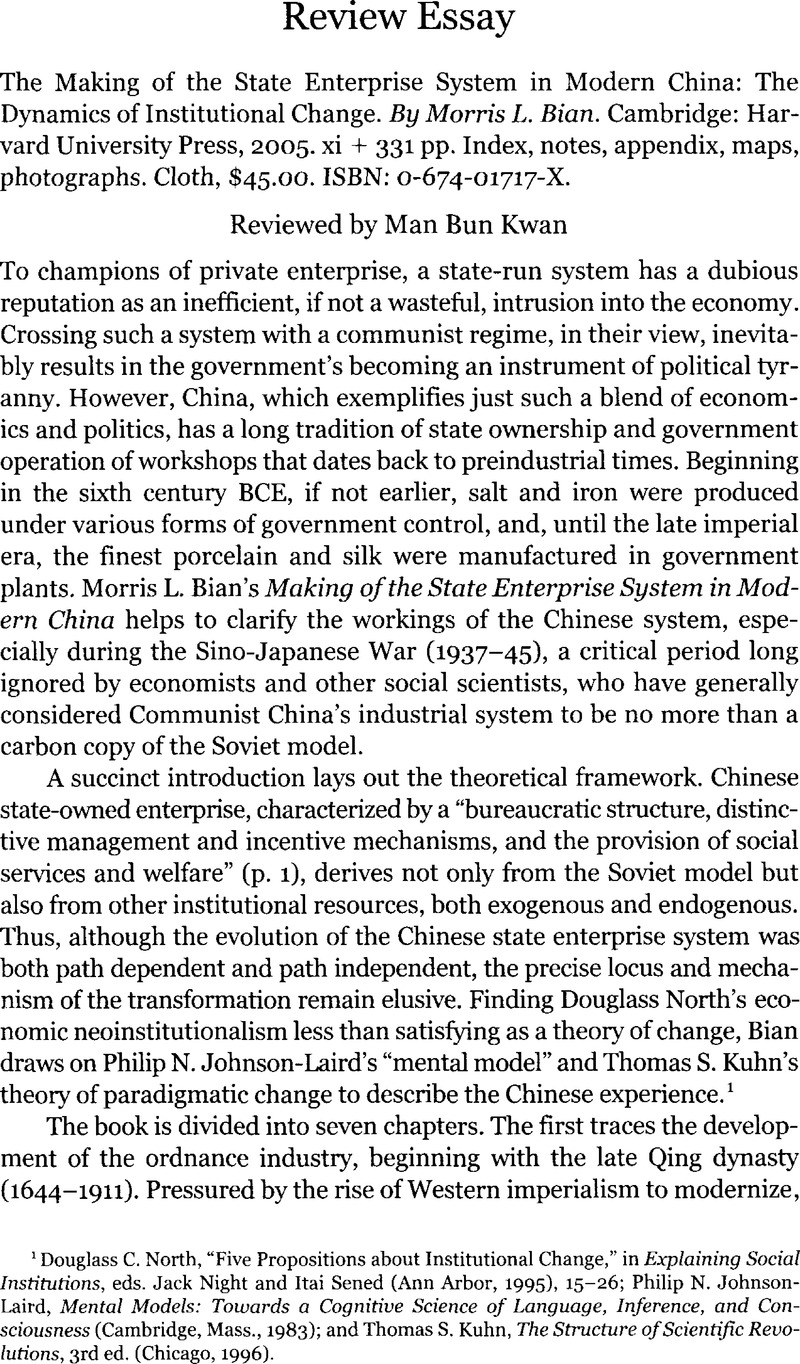No CrossRef data available.
Article contents
The Making of the State Enterprise System in Modern China: The Dynamics of Institutional Change
Published online by Cambridge University Press: 13 December 2011
Abstract

- Type
- Review Essay
- Information
- Copyright
- Copyright © The President and Fellows of Harvard College 2006
References
1 North, Douglass C., “Five Propositions about Institutional Change,” in Explaining Social Institutions, eds. Night, Jack and Sened, Itai (Ann Arbor, 1995), 15–26Google Scholar; Johnson-Laird, Philip N., Mental Models: Towards a Cognitive Science of Language, Inference, and Consciousness (Cambridge, Mass., 1983)Google Scholar; and Kuhn, Thomas S., The Structure of Scientific Revolutions, 3rd ed. (Chicago, 1996)CrossRefGoogle Scholar.
2 See, for example, Rui, Jian, “Guomindang guanliu ziben fazhan de gaishu” [An Outline Account of the Development of Bureaucratic Capitalism under the Nationalist Party], Zhongguojingjishi yanjiu [Studies in Chinese Economic History] 3 (1986): 97–118Google Scholar. The revision can be traced to the translation and publication of Toshino's, Ishijima “Guomindang zhengquan de kangri liliang” [The Strength of the Nationalist Government's Resistance against Japan], in Zhongguo jinjai jingjishi yanjiu ziliao [Research Materials on Modern Chinese Economic History] 2 (1984): 67–97Google Scholar.
3 Jiansheng, Xu, “Minguo Beijing, Nanjing zhengfu jingji zhengce de shixiang jichu” [Foundations of Economic Thought for the Republican Governments of Beijing and Nanjing], Zhongguo jingjishi yanjiu [Studies in Chinese Economic History] 3 (2003): 70–81Google Scholar.
4 Baoqin, Zhu, “Lun Nanjing guominzhengfu de gongye zhengce, 1927–1937” [An Analysis of the Industrial Policy of the Nanjing Nationalist Government, 1927–1937], Nanjing daxue xuebao [Bulletin of Nanjing University] 1 (2000): 130–36Google Scholar.
5 A control that continued beyond 1949. See Lanfang, Lin, Ziyuan weiyuanhui de tezhong kuangchan tongzhi, 1936–1949 [NRC and the Control of Special Minerals, 1936–1949] (Taipei. 1998), 189Google Scholar.
6 Zhang Jia'ao, letter to Weng Wenhao, 9 June 1943, as cited in Xuetong, Li, Huanmie de men—Weng Wenhao yu Zhongguo zaoqi gongyehua [A Vanished Dream: Weng Wenhao and China's Early Industrialization] (Tianjin, 2005), 188Google Scholar.
7 Shi-mo, He, Kangzhan shiqi zhuanmai shiliao [A Documentary Collection of State Monopoly during the Sino-Japanese War, 1941–1945] (Taipei, 1992)Google Scholar.
8 Xingsheng, Zhao, Chuantong jingyan yu xiandai shixiang—Nanjing guomin zhengfu shiqi de guoying gongye yanjiu [Traditional Experience and Modern Ideal: A Study of State Industrial Enterprise under the Nanjing Nationalist Government] (Jinan, Shandong, 2004), 257–87Google Scholar.
9 For instance, the NRC acquired 47 percent of the Tien Yuen electrochemical works in 1943. See Tianyuan, Shanghai huahongchang zhi bianshe waiyuanhui, compiled, Shanghai Tianyuan huagongzhang zhi [A Gazetteer of Tianyuan Chemical Works] (classified ed., Shanghai, 1994), 9–10Google Scholar.
10 Taichang, Wu, “Guomindang zhengfu Ziyuan weiyuanhui nongduan huodong pingshu” [On the Activities of the Nationalist Government's National Resource Commission], Zhongguo jingjishi yanjiu 3 (1986): 119–34Google Scholar.
11 S. A. Trone, letter to T.V. Soong, 26 Apr. 1943, in box 31, “Papers of T.V. Soong,” held at the Hoover Institution. However, A. N. Young, another American adviser, opined that Soong “believed in private enterprise.” See “A. N. Young diaries,” entry dated 21 Feb. 1946, in box 117, “A. N. Young papers,” held at the Hoover Institution.
12 Li Xuetong (2005), 112.
13 Gongbo, Chen, “Tongzhi jingji yu zuzhi” [Controlled Economy and Organization], Sinian congzhenglu [Four Years in Politics] (Shanghai, 1936), 174–92Google Scholar.
14 Fan Xudong's privately held Yongli Chemical Industries built the plant in 1937. See Nanjing huaxue gongye (jituan) gongsi Nanhuazhi bianweihui, compiled in Nanhuazhi [A Gazetteer of Nanjing Chemical Group] (Beijing, 1994)Google Scholar.
15 Yi, Xue, Guomin zhengfu Ziyuan weiyuanhui yanjiu [A Study of the Nationalist Government's National Resources Commission] (Beijing, 2005), 437Google Scholar. Surviving dossiers can be found at the Academia Historica and in the archives of the Institute of Modern History, Academia Sinica.
16 On the danwei as units of social control, see Shaw, Victor N., Social Control in China: A Study of Chinese Work Units (Westport, Conn., 1996), pt. 2Google Scholar.
17 Zhongmin, Zhang, “Luelun zhanhou Nanjing zhengfu guoyou qiye de guoyou gufen jianqi” [A Brief Analysis of the Nanjing Government's Divestment of State Shares in State-Owned Enterprises], in Zongmin, Zhang and Xingnong, Lu, eds., Qiye fazhanzhong de zhidu bianqian [Institutional Change in Chinese Business History] (Shanghai, 2003), 56–71Google Scholar.
18 The issue of property rights is revisited by Rong, Wang, Wan Qing Gongye chanquan zhidu de bianqian [Property-Right Changes in Late Qing Industries] (Kunming, Yunnan, 2004)Google Scholar. See also a 1947 proposal by Xu Qingfu to transfer ownership and operation of all state enterprise to a public holding commission, in box 5 (schedule B) of “T.V. Soong Papers.”




